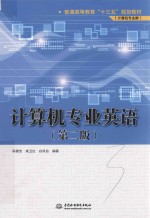

普通高等教育“十三五”规划教材 计算机专业英语 计算机专业群 第2版PDF电子书下载
- 电子书积分:11 积分如何计算积分?
- 作 者:孙建忠,姚卫红,白凤仙编著
- 出 版 社:北京:中国水利水电出版社
- 出版年份:2018
- ISBN:9787517072331
- 页数:266 页
Chapter1 The History and Future of Computers 1
本章学习指导 1
1.1 The Invention of the Computer 1
1.2 Computer Generations 2
1.3 Near-future Supercomputer Directions 6
Reading Material: Classes of Computing Applications and Their Characteristics 7
科技英语的特点 9
Exercises 11
Chapter2 Organization of Computers 12
本章学习指导 12
2.1 Basic Organization of Computers 12
2.2 CPU Organization 16
2.3 Memory Subsystem Organization and Interfacing 18
2.4 I/O Subsystem Organization and Interfacing 23
Reading Material: Eight Great Ideas in Computer Architecture 25
计算机英语专业词汇的构成 27
Exercises 31
Chapter3 Number Systems and Boolean Algebra 32
本章学习指导 32
3.1 Number Systems 32
3.2 Boolean Algebra 37
Reading Material:Moore's Law 39
数学公式的读法(Pronunciation of mathematical expressions) 41
Exercises 43
Chapter4 Data Structure 44
本章学习指导 44
4.1 An Introduction to Data Structures 44
4.2 Stacks 45
4.3 Queues 47
常用英汉互译技巧 49
Exercises 53
Chapter5 Operating System 55
本章学习指导 55
5.1 OS Function 55
5.2 Evolution of OS Function 58
5.3 OS Structure 59
被动语态的翻译技巧 63
Exercises 65
Chapter6 Software Engineering 66
本章学习指导 66
6.1 The Software Life Cycle 66
6.2 Design Methodologies 71
Reading Material: Software Security 73
复杂定语(从句)的翻译技巧之一 77
Exercises 80
Chapter7 Programming Languages 81
本章学习指导 81
7.1 Computer Languages 81
7.2 Object-Oriented Programming 82
Readinging Material: OMG's Unified Modeling Language(UML) 89
复杂定语(从句)的翻译技巧之二 91
Exercises 93
Chapter8 The Internet 95
本章学习指导 95
8.1 The Internet: Technology Background 95
8.2 The Internet Today 103
8.3 Internet II: The Future Infrastructure 109
Reading Material: Researcher Develops Colorful Map of the Internet 112
英语长句的翻译 113
Exercises 117
Chapter9 The World Wide Web 118
本章学习指导 118
9.1 Hypertext 118
9.2 Markup Languages 119
9.3 Web Servers and Clients 121
9.4 Web Browsers 122
Reading Material: The Internet and The Web: Features 123
学术论文的英文写作简介 127
Exercise 130
Chapter10 Computer and Network Security 131
本章学习指导 131
10.1 Characteristics of Computer Intrusion and Kinds of Security Breaches 131
10.2 Modern Cryptography-Data Encryption 133
10.3 How Firewalls Work 136
科技论文标题的写法 139
Exercises 141
Chapter11 Big Data 142
本章学习指导 142
11.1 WhatIsBigData? 142
11.2 Cross-Disciplinary Approach, New Skills, and Investment 145
11.3 Acquiring Relevant Data 146
11.4 The Basics of How Big Data Technology Works 146
Reading Material: The Impact of Big Data on Discovery 147
英文摘要的写作技巧 148
Exercises 152
Chapter12 Multimedia 154
12.1 Multimedia 154
12.2 Elements of Multimedia 156
12.3 Introduction to Computer Graphics 158
12.4 Computer Animation 161
Reading Material: an Introduction to and History of Virtual Reality 163
英文论文引言的写作技巧 165
Exercises 171
Chapter13 Anatomy of the Internet of Things 172
学习指导 172
13.1 Traditional Internet Protocols Aren't the Solution for Much of the IoT 173
13.2 It's All Relative 177
13.3 Applying Network Intelligence at Propagator Nodes 180
Reading Material: Machine learning: what and why? 186
求职英语简介 186
Exercises 189
Chapter14 Cloud Computing 191
学习指导 191
14.1 Definitions 191
14.2 Related Technologies for Cloud Computing 193
14.3 Cloud Service Models 196
14.4 Cloud Deployment Models 197
14.5 Public Cloud Platforms: State-of-the-Art 198
14.6 Business Benefits of Cloud Computing 200
Reading Materials: Advanced technologies in cloud computing 201
广告文体简介 202
Exercise 204
参考译文 205
第1章 计算机的历史与未来 205
第2章 计算机的组成 208
第3章 数制与布尔代数 214
第4章 数据结构 218
第5章 操作系统 220
第6章 软件工程 225
第7章 程序设计语言 228
第8章 因特网 231
第9章 万维网 239
第10章 计算机与网络安全 242
第11章 大数据 246
第12章 多媒体 250
第13章 物联网的剖析 254
第14章 云计算 260
参考文献 266
- 《计算机网络与通信基础》谢雨飞,田启川编著 2019
- 《大学计算机实验指导及习题解答》曹成志,宋长龙 2019
- 《全国高等中医药行业“十三五”创新教材 中医药学概论》翟华强 2019
- 《MBA大师.2020年MBAMPAMPAcc管理类联考专用辅导教材 数学考点精讲》(中国)董璞 2019
- 《中央财政支持提升专业服务产业发展能力项目水利工程专业课程建设成果 设施农业工程技术》赵英编 2018
- 《党员干部理论学习培训教材 理论热点问题党员干部学习辅导》(中国)胡磊 2018
- 《“十三五”规划教材 中药鉴定学实验 供中药学 药学及相关专业使用 第2版》吴啟南 2018
- 《广西近代专业音乐研究》李昂责任编辑;(中国)杨柳成 2019
- 《危险化学品经营单位主要负责人和安全生产管理人员安全培训教材》李隆庭,徐一星主编 2012
- 《计算机辅助平面设计》吴轶博主编 2019
- 《中风偏瘫 脑萎缩 痴呆 最新治疗原则与方法》孙作东著 2004
- 《市政工程基础》杨岚编著 2009
- 《家畜百宝 猪、牛、羊、鸡的综合利用》山西省商业厅组织技术处编著 1959
- 《《道德经》200句》崇贤书院编著 2018
- 《高级英语阅读与听说教程》刘秀梅编著 2019
- 《计算机网络与通信基础》谢雨飞,田启川编著 2019
- 《看图自学吉他弹唱教程》陈飞编著 2019
- 《法语词汇认知联想记忆法》刘莲编著 2020
- 《培智学校义务教育实验教科书教师教学用书 生活适应 二年级 上》人民教育出版社,课程教材研究所,特殊教育课程教材研究中心编著 2019
- 《国家社科基金项目申报规范 技巧与案例 第3版 2020》文传浩,夏宇编著 2019
- 《中国当代乡土小说文库 本乡本土》(中国)刘玉堂 2019
- 《异质性条件下技术创新最优市场结构研究 以中国高技术产业为例》千慧雄 2019
- 《中国铁路人 第三届现实主义网络文学征文大赛一等奖》恒传录著 2019
- 《莼江曲谱 2 中国昆曲博物馆藏稀见昆剧手抄曲谱汇编之一》郭腊梅主编;孙伊婷副主编;孙文明,孙伊婷编委;中国昆曲博物馆编 2018
- 《中国制造业绿色供应链发展研究报告》中国电子信息产业发展研究院 2019
- 《中央财政支持提升专业服务产业发展能力项目水利工程专业课程建设成果 设施农业工程技术》赵英编 2018
- 《中国陈设艺术史》赵囡囡著 2019
- 《指向核心素养 北京十一学校名师教学设计 英语 七年级 上 配人教版》周志英总主编 2019
- 《《走近科学》精选丛书 中国UFO悬案调查》郭之文 2019
- 《清至民国中国西北戏剧经典唱段汇辑 第8卷》孔令纪 2018
